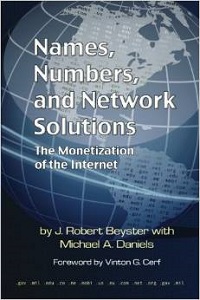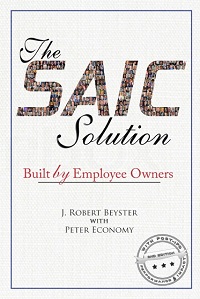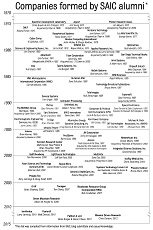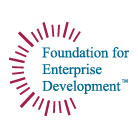I have been spending some time lately putting together a time line of key events in SAIC’s history for the book. It has been good to consider the many remarkable things we accomplished together, and I think our readers will find value in it. My question for you is this: What do you think are the key events in SAIC history? This might be the award of a certain contract, or the acquisition of a particular company, or the opening of an office or new business unit, or any number of other events. Please provide what the event was, when it occurred, and why it was important to the company.
Click on the comments link to share your thoughts.
- Bob
Here are comments on some of your responses:
Barry Shillito (Week 3): I feel that by and large the contributions from individual board members were solicited, and they endeavored to support us with help on our difficult board and management decisions. And we had a lot of difficult decisions. Towards the end of my tenure on the board, things got rather complicated. Although I tried to be helpful and made many recommendations to the board, the majority of its members was clearly not in sympathy with my recommendations. As a result, SAIC has changed — and will continue to change. SAIC is an incredibly strong company, and it seems to be weathering the new environment. I hope SAIC will do well as a public company and staff will remain as dedicated and supportive of the line management as they always have.
Hemmo Alting-Mees (Week 4): I believe that the accomplishments of the Electronic Vision Division are included in the book. If they’re not, I’ll see what I can do to include them. The development of the digicon was something unique to be proud of. Others had tried it and failed.
Scott Fiero (Week 7): STRATCOM is one of my favorite organizations and, over time, I have had the pleasure of working with a number of people like you who are equally interested in the mission of the command. The stock reward program in SAIC of course was designed to recognize such efforts, and I’m pleased to see you were part of it. I always felt that with STRATCOM, the work we were doing was especially important.
Duane Hove (Week 8): By now, I have responded to a number of blog comments about SAIC, and these comments vary considerably. The most prevalent attribute of SAIC that we run into is of course employee ownership. However, you’re right — lots of people are happy just to have the privilege to work in a good environment where the management was supportive in encouraging and recognizing achievement.
Jeff Van Fleet (Week 11): I’m glad SAIC helped you. What was the biggest thing employee ownership allowed you to do? Maybe some people don’t value it highly. I’m wondering why you value it so highly, although I’m glad you do.
Chris Rowe (Week 11): I have a couple of questions for you. First, please explain “CCOE practice.” And, second, please include the name of your new company so we can add it to our list.
Cecelia McCloy (Week 11): We’ll make sure you’re included as a spin-off of SAIC — it sounds like you are doing well and have the right idea on priorities for running your employee-owned business. Long-term customer relationships and high quality are indeed in my experience the most important things to focus on in a company, whether large or small.
Rich Crawford (Week 12): Your description of the employee participation methodology is right on target, and we are addressing this in the book.
William Grossman (Week 12): Your view of SAIC describes the unique culture we tried to build at SAIC, and it is beautifully written.
Charlie Stevens (Week 12): Good to hear from you, Charlie. You and Gerry Pomraning made a big contribution to retirement plans and the stock bonus system at SAIC. Those early days set the stage for the continued expansion of the ways we could reward stock to employees, while further expanding their stock ownership potential. It’s interesting how many different plans we ended up having.





I believe the award and successful execution of the RSNF C3 contract in ~ 1983-87 was significant turning point for SAIC. It was the first large systems integration contract for SAIC, $400 M, very profitable. I was fortunate to be the Director of contracts and finance for the Military Sciences Group and helped to support this contract. Our customer was the US Navy on behalf of the Roygal Saudi Navy. With the execution of this contract, SAIC was now able to claim its excellence as a IT systems integration contractor.
Greetings, Dr. Beyster!
My answer is from a different perspective — I think a really important event was when we implemented AJOBB, the job posting site, back in the early 90′s. Why? Because it was a milestone and a message to the employee owners – It said that we had become too big to just call a friend and tell them we had a job for them. It said we value those we’ve hired, and opened up for them the opportunity to have a career, to move around, to experience the SAIC world beyond their original four walls. It was a message that there would be a future at SAIC, and they could stay with the company for many years doing many different things. And it said that we want to give all employees an equal opportunity to move up in the company. Granted, it didn’t always work perfectly, and it still doesn’t — but it was a start that we’ve continued to improve.
Stay well, Dr. Beyster! (I miss you, too —)
Mary Lou
Hello Dr. Beyster
Although I left a long time ago (1989) to start my own energy consulting business, I have never stopped being grateful to you for giving me the chance to participate in SAIC’s success as an employee owner. Even though I’m retired, SAIC has remained one of my primary investments.
I will say the key event in SAIC’s history was the day in 1978 that I received my first stock certificate. I would go on to say that thousands of employee owners would agree with me. It was the motivation from ownership that caused me to work so hard in developing my energy division at SAIC and motivated so many other owners to work their magic for the company.
I can’t sign off without asking you to recall the low point of my career in the mid-1980s. It seems you wanted to award me employee of the month because my division had won about two dozen contracts in a row from commercial energy companies. Your secretary called me to request that I give a talk about our success at the quarterly management meetings, without mentioning the honor to be bestowed. I declined to speak as we were “on a roll” and I didn’t want to interrupt it by preparing a speech. After the meetings, you let me know what my response should have been and, to my surprise, gave me the award. Thanks!
Craig Racine
A ajor event in our early years was the award of the RSNF C3 contract. It was remarkable because its net value was more the the company’s entire annual revenues of that year. It was also remarkable because it was a cold proposal to an item first seen in the CBD. This was never in anyone’s “strategic plan”. It makes a strong case for allowing at least some exceptions to the plan to be pursued and allowing SAIC entrepreneurial opportunism to work.
It was also notable in the “lessons learned” category due to the way the discretionary overhead generated was controlled. The organization that landed the contract sent a lot of the work to other organizations, but contrary to company policy at the time, did not send the discretionary overhead with it. The rationale was that there was an enormous gap coming at the end of the contract and that only they knew best how to fill it. After one win, there were a huge unbroken string of competitive losses and the gap was not filled. Others in the company did fill it in a model of how success oscillated from one part of the company to another and the company contnued to grow on thes Brownian motion events. This was a painful case study in why all of us are smarter than any of us.
While there have been many contracts that have moved the company forward, I would suggest that information system evolution played a key role. First — the MIS and contracts systems (so that we had a way to track timesold); second, the RFP tracking system (to prevent people from bidding against each other); third would be email (it made a HUGE difference in how people collaborated); and fourth, ISSAIC and the web (which allowed the company to begin to structure and organize itself into a coherent $B company). Being a decentralized company, SAIC really needed these IT advances to help it get its act together. These tools and technologies helped us to better support our customers and build business on both the $100K and the $100M projects.
Rizzi
I think CHCS was a key contract for the company in many ways.
It was the first time the company did a full scale system integration, deployment operations and support on such a huge scale. The contract required that we write the software, procure and integrate the hardware and communications components, build computer rooms in each hospital and wire all of the 700 hospitals and clinics and install over 2500 computers, 250,000 printers and terminals. We then had to operate all of these individual, yet identical, integrated health care management systems in over 700 military medical treatment facilities around the world from the largest like Walter Reed down to a hospital ship or a Mash unit using a portable version of the system. We trained over 500,000 system users and operated a world wide 24×7 help center. Internally we had to create a cost accounting system that could support such a huge number of tasks, charge numbers, commitments and bills of materials.
Despite the large number of change orders; Congressional, DoD and GAO oversite activities; and technical challenges we completed the contract on time and under budget. The system was widely recognized as one of the top informations systems projects in the US Government and won numerous awards from the hospital information systems community. SAIC also grew to become one of the top 5 health care information systems companies in the United States based on our revenue and number of employees.
All of these accomplishments, along with the $billion scale of the contract, were major “firsts” for the company and the experience and internal systems we put in place to complete these tasks were used through out the company to to help win and perform on such diverse contracts as BP, PDVESA, Entergy, Oak Ridge and Kaiser Permanente.
In January, 1971, Dr. Chris Bush and myself, joined SAIC from TRW Systems Group in Redondo Beach, CA. I believe we were the first of many TRW employees hired by SAIC. Chris and I spent our first two weeks in La Jolla in McKellar Plaza borrowing offices and writing proposals to DNA and SAMSO. I borrowed Gerry Pomeraning’s office overlooking the cove and spent most of the time watching the whales migrate. I wondered why Chris and I were supposed to open the third SAIC office (after La Jolla and Wash DC) in Los Angeles; but we did. It was a conduit for many TRW employees on there way to La Jolla as well as many who stayed in LA. Our first office was in the LA airport area and soon moved to El Segundo. Chris and I were recruited by Dr. Beyster and Dr. Gene Ray in the Systems Group to establish an LA presence and get Air Force V&H business. This office evolved over the years and many different SAIC organizations into a large LA area presence. Chris left SAIC in 1975 to found Spectron Development Lab. I managed the LA office until 1979 when I finally found a way to move to La Jolla. THat didn;t work out as well as I hoped, and I left SAIC in 1982 to found my own company, then mergered it with SPARTA in 1983, and founded my current company, DR Technologies, Inc. in 1994.
Dr. Beyster:
Sorry for the delay, i will check in more often moving forward…
In response to your question:
CCOE Practice was the Cisco Center of Excellence we formed in Red Bank, NJ in 2002 to bring SAIC to Cisco Gold Partner status, and provide all the Groups (now BU’s) with Cisco Certified Engineering Support, primarily VoIP support. We had initially installed Cisco VoIP in NYC pre-9/11 as you may recall, and assisted stranded NYC workers coming over to Jersey City with IP Phone access to call their loved ones on that day.
After 9/11, our team led TSA’s Cisco VoIP Rollout for SAIC through Unisys, and the business has taken off from there.
My team (4 guys…), left SAIC in May to begin an East practice for Infra-Comm Corporation, headquartered in San Juan Capistrano, CA – small Woman-Owned Business that has 6 employees (now 10…) where from my days in working at SAIC Hermosa Beach and Torrance, we had conducted business with Luke Hosinski, President of Infra-Comm, who has been an avid admirer of SAIC for over 20 years, and has helped me on occassion through his prospective of the industry.
It just made sense at this time, to make the transition and join up with Luke. He has made the committment to me that ownership in his company is what will inspire me and my team to grow our VoIP Practice – I fully trust Luke in making this happen for us.
My focus is on both Federal and Commercial enterprises and it appears that VoIP is really starting to gain momentum in both market segments – and Cisco is getting their usual Lion’s share – so, I’m not afraid to be a one-trick pony, for now anyway ;>)
Thank You again for everything you have done to support me and my quest to get SAIC an improved business practice around this technology – I hope in the end, I was a benefit to the company – i know i tried…
Thanks,
Chris
Infra-Comm Corporation
1330 Laurel Avenue
Suite 305
Sea Girt, NJ 08750
Office: 732.974.6400 x201
Cell: 202.689.9191